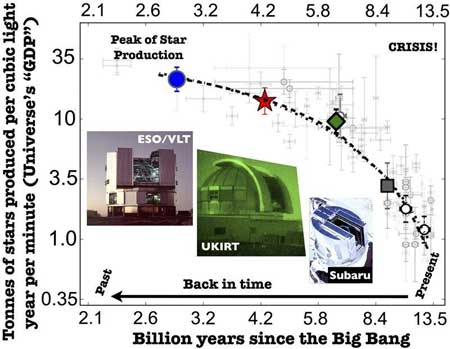The heavens were once a blaze with young, brilliant megastars. But those days are long gone.
The
production rate of new stars in our universe is now 30 times less than
in the heyday, 11 billion years ago. So concluded the largest ever study
of star formation.
Our
juvenile universe was nearly devoid of carbon and fraught with withering
radiation and cataclysmic explosions from frenzied, short-lived,
monster stars. It probably could not support life.
The elderly
universe will slowly fade to black. Accelerating expansion will carry
distant galaxies ever farther and aging stars will eventually twinkle
their last. With ever-fewer new stars, the universe will become
progressively colder and less habitable.
We exist in the prime of our universe — after the fire, and before the ice.
An
international team of astronomers from Portugal, UK, Japan, Italy, and
the Netherlands measured the amount of ionized hydrogen in star-forming
galaxies at various epochs in our universe’s history. When stars form,
their intense radiation ionizes nearby hydrogen atoms, separating their
electrons and protons. Later these recombine and emit light of a
characteristic wavelength called Hα, the hydrogen alpha line.
Using the
UK Infrared, the ESO/VLT, and the Subaru telescopes, the team studied Hα
emissions from two areas of the sky covering 2 square degrees, about 4
times the area covered by our Moon. They identified 3701 Hα-emitting,
star-forming galaxies at distances out to redshift z=2.23, corresponding
to 10.6 billion light-years.
If a
galaxy’s light has traveled 10.6 billion light-years to reach Earth,
that light reveals the galaxy as it was 10.6 billion years ago, when the
light we see today began its journey. Hence, as astronomers look at
ever-farther distances they view progressively earlier periods in our
universe’s history. We don’t have to guess what happened in the cosmic
past; we see the past in our telescopes.
The
expansion of our universe is due to the stretching of space. As it
stretches so do the wavelengths of light passing through it — the light
is redshifted. A redshift of z=2.23 means light’s wavelength is now 3.23
times longer, and the universe is now 3.23 times larger in each
direction, than when the light was emitted. From Einstein’s General
Relativity and cosmological measurements, we can compute how long ago
that was.
Star
formation rates were measured at four redshifts, z=0.40, 0.84, 1.47 and
2.23, corresponding to 4.2, 7.0, 9.2 and 10.6 billion years ago. They
found a 30-fold decline in star formation rate, as shown below on a
logarithmic scale. The study didn’t mention this, but the 30-fold
decline happens to match the universe’s 30-fold volume expansion and
30-fold decline in matter density over the same period.

Astronomers
believe the first stars formed about 300 million years after the Big
Bang, or about 13.5 billion years ago. Some of the first stars were
hundreds of times more massive and millions of times brighter than our
Sun. These monsters were short-lived, exploding within a million years
in spectacular supernovae. Subsequent stars were less massive and burned
more slowly. Smaller stars can live for billions or even trillions of
years. Our Sun is now 4.6 billion years old, and will probably burn for
another 5 to 6 billion years.
This study
says half the stars in our universe are between 9 and 11 billion years
old; those that are Sun-like are now at the end of their lives. Team
leader David Sobral of the University of Leiden said: “If the measured
decline continues, then no more than 5% more stars will form over the
remaining history of the cosmos, even if we wait forever.”
Billions of years ago, our universe was probably uninhabitable, as it will be again billions of years from now.
This is the Golden Age, my friends; enjoy life while the good times last.
Best Regards,
Robert
June 18, 2013
Note: Previous newsletters can be found on my website.
|